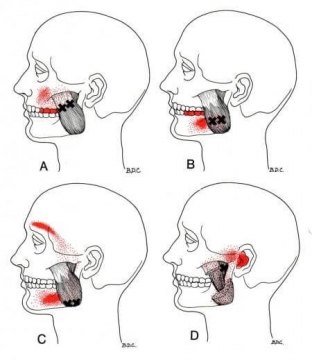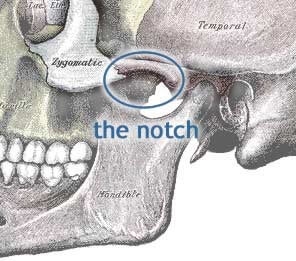Chetering muscle – not the only, but the main muscle responsible for the chewing process. She "covers" lateral parts of the jaw, located directly behind the cheekbones. This muscle is responsible for lifting the lower jaw, due to which the teeth are compressed.
Unfortunately, it is the masticatory muscles of the face that are one of the most common locations of trigger points in the human body. M. masseter is in many cases associated with bruxism, temporomandibular syndrome, and headaches. estet-portal.com will tell you more about the trigger points of the masticatory muscles of the face in this article.
The chewing muscles of the face – strong and special
The chewing muscle of the face – not only a place of concentration of trigger points, but also one of the strongest muscles in the human body.
The strength of the masticatory muscle is due to its multi-feathered structure – its fibers are intertwined and approach several internal tendons diagonally. This arrangement of muscle bundles makes muscle movements slow, but quite powerful and effective.
The chewing muscle of the face – not only a place of concentration of trigger points, but also one of the strongest muscles in the human body.
In some cases, chewing muscles can be inconvenient, so estet-portal.com will talk about:
- problems caused by facial masticatory muscles;
- massage of trigger points of masticatory muscles of the face;
- ways to prevent the appearance of trigger points of the masticatory muscles of the face.
Problems that can be caused by the chewing muscles of the face
It is easy to guess that regular massage will not damage the chewing muscles of the face, because during emotional stress, anger and anger, we often clench our jaws. Therefore, overvoltage m. masseter – a frequent occurrence. Muscle clamps in this case can cause:
- Tension headaches
The link between masticatory muscle overexertion and tension headaches is fairly obvious. Remember how you reflexively massage the temporal muscle with headaches. However, the masticatory muscle in this case also needs attention and massage, therefore it is necessary to massage with tension headache not only above the zygomatic bone, but also under it. Point #7.
- Tooth and ear pain
Less obvious, but quite real symptoms of overexertion of the masseter muscle – toothache, unexplained pain, discomfort and itching deep in the ear.
- Bruxism
Teeth grinding (bruxism) can also result from hypertonicity of the masticatory muscles, which leads to premature wear and tear of the teeth.
- Ringing in the ears and dizziness
It is important to remember that these symptoms can occur for a variety of other reasons, but overexertion of the masticatory muscles can exacerbate them.
- Temporomandibular Joint Syndrome
This syndrome is characterized by dysfunction of the temporomandibular joint, accompanied by pain and limited mobility. In severe cases, this problem can interfere with normal eating and sleep, as well as pain and ringing in the ears.
Overtension of masticatory muscles is manifested by headache and toothache, ringing and pain in the ears, and can also lead to dysfunction of the temporomandibular joint.
Massage of trigger points of masticatory muscles of the face
The image below shows trigger points (black crosses) and referred pain patterns (red) of the masticatory muscles of the face.

Fortunately, self-massage of the masticatory muscles of the face is very easy to perform. M. masseter departs from the lower part of the zygomatic bone and is attached with its lower part to a wide area in the lateral part of the jaw (see Fig.).
Find the "perfect spot" it is not difficult to massage the masticatory muscle: it is located in a small cavity located in the lower part of the zygomatic bone, into which the fingertip fits perfectly. When pressing on the point (and you can press on it quite strongly), you will feel a pleasant pain:

The other trigger points of the masticatory muscles will be more sensitive, so the massage movements should be gentle, smooth and not too strong.
Simple exercises to relax the masticatory muscles of the face
Massage of trigger points of masticatory muscles of the face – a great way to get rid of the discomfort associated with their overexertion. To prevent the appearance of trigger points in this area, estet-portal.com also suggests performing simple exercises aimed at relaxing the jaw and masticatory muscles.
Exercise #1
Try speaking as if you just woke up and can't pronounce the words clearly. Set yourself up for a wave of relaxation, imagine that you are so relaxed that you cannot speak clearly. This is a very simple and at the same time effective exercise that will help relieve tension from the chewing muscles.
Exercise #2

Open your mouth in surprise, and try to sit without closing it for as long as possible. Do this exercise regularly to wean yourself from the habit of clenching your jaw and overexerting your chewing facial muscles.
Read also: Ladder muscle massage for pain in the neck, chest, arms and upper back
Of course, we should not forget that all muscles of the human body are interconnected. Incorrect body position while walking or sitting can lead to hypertonicity of some muscles and weakening of other muscles. For example, often stretching the neck forward (for example, while watching the news on a smartphone) can also lead to pain in the head, shoulders and neck.
Therefore, when you massage the trigger points of the masticatory muscles of the face, do not forget about other muscles, as well as their role in causing discomfort in the body.






Add a comment